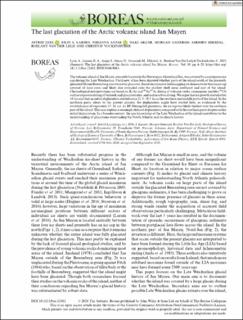| dc.contributor.author | Lyså, Astrid | |
| dc.contributor.author | Larsen, Eiliv | |
| dc.contributor.author | Anjar, Johanna | |
| dc.contributor.author | Akçar, Naki | |
| dc.contributor.author | Ganerød, Morgan | |
| dc.contributor.author | Hiksdal, Asbjørn | |
| dc.contributor.author | van der Lelij, Roelant | |
| dc.contributor.author | Vockenhuber, Christof | |
| dc.date.accessioned | 2021-02-10T10:47:46Z | |
| dc.date.available | 2021-02-10T10:47:46Z | |
| dc.date.created | 2020-11-16T14:14:08Z | |
| dc.date.issued | 2020 | |
| dc.identifier.citation | Lyså, A., Larsen, E. A., Anjar, J., Akçar, N., Ganerød, M., Hiksdal, A., Van Der Lelij, R. & Vockenhuber, C. (2021). The last glaciation of the Arctic volcanic island Jan Mayen. Boreas, 50(1), 6-28. | en_US |
| dc.identifier.issn | 0300-9483 | |
| dc.identifier.uri | https://hdl.handle.net/11250/2727148 | |
| dc.description.abstract | The volcanic island of Jan Mayen, remotely located in the Norwegian‐Greenland Sea, was covered by a contiguous ice cap during the Late Weichselian. Until now, it has been disputed whether parts of the island south of the presently glaciated Mount Beerenberg area were ever glaciated. Based on extensive field mapping we demonstrate that an ice cap covered all land areas and likely also extended onto the shallow shelf areas southeast and east of the island. Chronological interpretations are based on K‐Ar and 40Ar/39Ar dating of volcanic rocks, cosmogenic nuclide (36Cl) surface exposure dating of bedrock and glacial erratics, and radiocarbon dating. We argue that ice growth started after 34 ka and that an initial deglaciation started some 21.5–19.5 ka in the southern and middle parts of the island. In the northern parts, closer to the present glaciers, the deglaciation might have started later, as evidenced by the establishment of vegetation 17–16 cal. ka BP. During full glaciation, the ice cap was likely thickest over the southern part of the island. This may explain a seemingly delayed deglaciation compared with the northern parts despite earlier initial deglaciation. In a broader context, the new knowledge of the Late Weichselian of the island contributes to the understanding of glaciations surrounding the North Atlantic and its climate history. | en_US |
| dc.language.iso | eng | en_US |
| dc.rights | Attribution-NonCommercial-NoDerivatives 4.0 Internasjonal | * |
| dc.rights.uri | http://creativecommons.org/licenses/by-nc-nd/4.0/deed.no | * |
| dc.title | The last glaciation of the Arctic volcanic island Jan Mayen | en_US |
| dc.type | Peer reviewed | en_US |
| dc.type | Journal article | en_US |
| dc.description.version | publishedVersion | en_US |
| dc.rights.holder | © 2020 The Authors. | en_US |
| dc.source.pagenumber | 6-28 | en_US |
| dc.source.volume | 50 | en_US |
| dc.source.journal | Boreas: An international journal of Quaternary research | en_US |
| dc.source.issue | 1 | en_US |
| dc.identifier.doi | https://doi.org/10.1111/bor.12482 | |
| dc.identifier.cristin | 1848380 | |
| cristin.ispublished | true | |
| cristin.fulltext | original | |
| cristin.qualitycode | 2 | |

